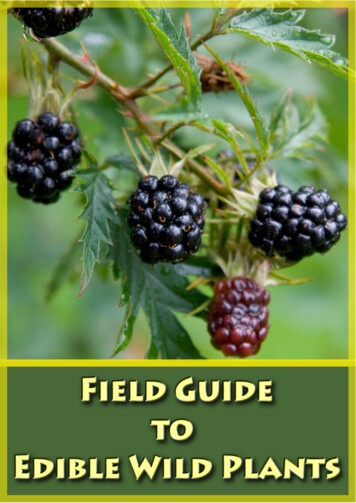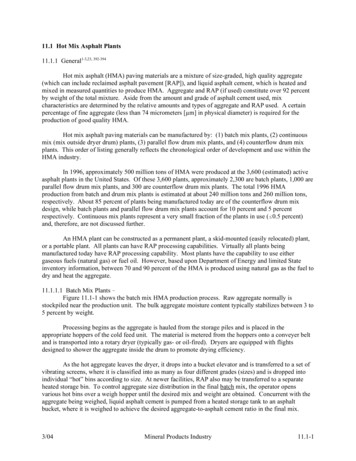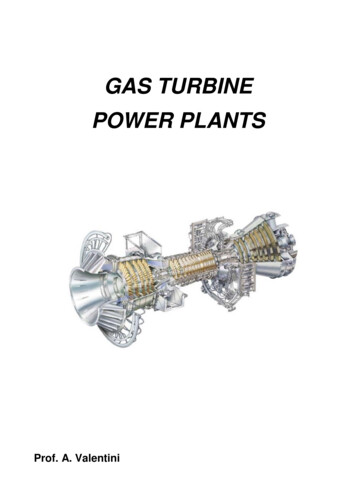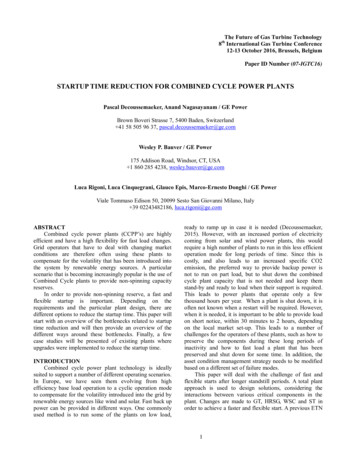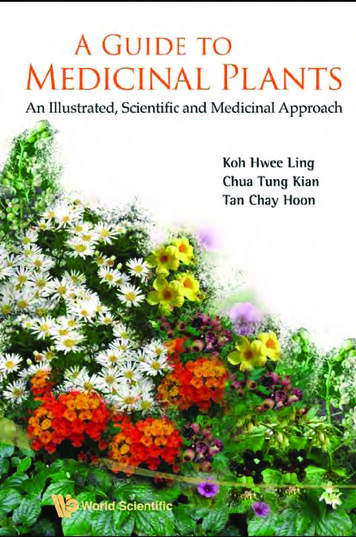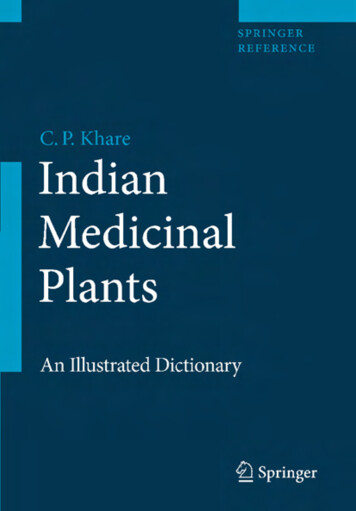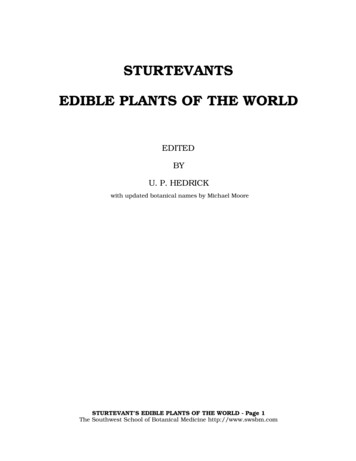
Transcription
STURTEVANTSEDIBLE PLANTS OF THE WORLDEDITEDBYU. P. HEDRICKwith updated botanical names by Michael MooreSTURTEVANT’S EDIBLE PLANTS OF THE WORLD - Page 1The Southwest School of Botanical Medicine http://www.swsbm.com
To the Board of Control of the New York Agricultural ExperimentStation:GENTLEMEN.—It gives me peculiar pleasure to transmit to you forpublication a manuscript prepared from notes by Dr. E. LewisSturtevant, the distinguished first Director of this Station, thepublication to be known as " Sturtevant's Notes on Edible Plants."Dr. Sturtevant was one of that group of men who early espoused thecause of agricultural science in the United States, a field in which hebecame distinguished, his studies in economic botany being one of hisnotable achievements. When he retired in 1887 as Director of thisStation, he left behind him a voluminous manuscript consisting of acompilation of existing knowledge on the edible food plants of theworld, a piece of work involving a laborious and extended research inbotanical literature. For twenty years this manuscript remaineduntouched, when Dr. U. P. Hedrick undertook its editing, a difficult andarduous task, well performed, in order that so valuable a collection ofknowledge might become available to botanists and to students of foodeconomics.It is especially appropriate that such a volume should be issued at thistime. Food problems are becoming more and more acute as the demandfor food increasingly overshadows the supply. Primitive peoplesdepended upon food resources which are now neglected. Other sourcesof possible human nutrition have doubtless remained untouched, andthe time may come when a comprehensive utilization of food plants willbe essential to human sustenance. It is believed, therefore, that theinformation so ably brought together by Dr. Sturtevant cannot fail tobecome increasingly useful.Very respectfully,W. H. JORDANDirectorNEW YORK AGRICULTURAL EXPERIMENT STATION GENEVA, N. Y.June 1, 1919.STURTEVANT’S EDIBLE PLANTS OF THE WORLD - Page 2The Southwest School of Botanical Medicine http://www.swsbm.com
PREFACEAll who have attempted to study the origin and history of cultivatedplants must have been struck with the paucity and inaccuracy ofinformation on the subject. For nearly nineteen hundred years, to bewritten in Pliny was proof sufficient; yet much of Pliny's history isinaccurate though still repeated in periodicals and popular works.Linnæus, the great system-atizer, gave the origin of most of the plantshe described; but of these, De Candolle, by long odds the best planthistorian, says, " three out of four of Linnaeus' indications of theoriginal home of cultivated plants are incomplete or incorrect." DeCandolle, in his turn, usually accurate, is exceedingly scant, giving theorigin of but 249 cultivated plants, not all edible, while Sturtevant, inthe text in hand, puts down 2897 which may be used for food, most ofwhich are cultivated.The query at once comes to mind as to the respects in which Sturtevantadds new knowledge on an old subject. New knowledge may be foundon the following subjects: (i) The original home of many esculents isgiven for the first time. (2) New landmarks in the histories of edibleplants are pointed out. (3) An effort is made to mention all cultivatedesculents. (4) Though the book contains much new information as tothe history of the food plants of the Old World, it is especially full andaccurate in the discussion of the esculents of the New World. (5)Sturtevant presents much new information on the variations that havebeen produced in plants by cultivation. (6) His book adds much togeographical botany. (7) He contributes much data for the study ofacclimatization.It is pertinent to inquire as to the qualifications and opportunitiesSturtevant may have had to illuminate so vast a subject as that ofedible plants. To answer this query, and for the added reason that abook can be used with greatest profit only when its author is known, abrief biography of Sturtevant follows this Preface.Sturtevant's Notes on Edible Plants is a compilation from four sources,namely: the first seven reports of the New York State AgriculturalExperiment Station; a manuscript of 1600 closely written imperialoctavo sheets entitled, Notes on Edible Plants, left at this Station by theauthor; a series of articles in the American Naturalist on the history ofgarden vegetables, running for four years beginning with 1887; andbetween forty and fifty thousand card index notes which belong in partSTURTEVANT’S EDIBLE PLANTS OF THE WORLD - Page 3The Southwest School of Botanical Medicine http://www.swsbm.com
to this Station and in part to the Missouri Botanical Garden. Thematerial used was written previous to 1892, the author having spent atleast a quarter-century in its preparation. The editor must now statewhat his task has been.With so great a wealth of material much has had to be discarded. Agreat mass of cultural notes has not been used. Descriptions of manyvarieties of many species were discarded. Vernacular names in manylanguages and dialects were omitted. Botanical synonyms have had tobe left out. Sturtevant's discussions of edible fungi, while full for thetime in which they were written, are, in the light of recent research, soscant and fragmentary that the editor, unable to revise or add to them,has with many regrets excluded them. The unused material amounts toseveral times that used.After sorting the material, the next task was to arrange it forpublication. This work fell into four well-defined divisions of labor:First, some standard of botanical nomenclature had to be adopted thatthe many botanical names from the several hundred authors quoted bySturtevant could be made to conform as far as possible to onestandard. Index Kewensis was taken as the authority best suited for thework in hand; this standard has seldom been departed from eventhough departure seemed most necessary in the light of later botanicalstudies; to have begun making departures would have entailed toogreat a task.Second, Sturtevant's citations to literature1 , except in the series ofarticles in the American Naturalist, usually consist only of the name ofthe book and the author. Since a book such as this is almost worthlesswithout full citations, these, as far as possible, have been completedand verified, a task requiring borrowed books from a dozen or morelibraries and the labor of several persons for months. Even after greateffort to insure fullness and correctness, no doubt many mistakes havecrept into the citations.Third, bibliographical information is given in detail, since to citeunknown authors is a worthless procedure. It seems a simple task tocatalog a collection of books. But the difficulties, especially in the caseof early books, were found to be many. Anonymous writers, noms deplume, cross-references, borrowed material, numerous editions, works1I have deleted the many 100-150-year-old footnoted references - MMSTURTEVANT’S EDIBLE PLANTS OF THE WORLD - Page 4The Southwest School of Botanical Medicine http://www.swsbm.com
of commentators and editors bearing the names of original authors, allconfuse and make the task of the bibliographer complex and difficult.Fourth, the material had to be arranged. Sturtevant in his discussionsof vegetables in the reports of this Station, in his card index of edibleplants and in his History of Garden Vegetables in the AmericanNaturalist, arranges the plants in accordance with the Englishvernacular names; but in his partly completed manuscript,undoubtedly written with the expectation of publishing, the plants arearranged alphabetically according to genera. The last plan seemed tosuit the present work best and was adopted. The natural order of thegenera is given; species are alphabetically arranged under each genera;while, to make them as prominent as possible, English vernacularnames are printed in capitals after the species. The vernacular namesare those used by the authorities quoted or are taken from standardbotanical text-books.While the changes and omissions made by the editor leave that whichremains substantially as written by Dr. Sturtevant, yet there has beenso much cutting and fitting that it would be unjust to hold Sturtevantresponsible for infelicities that may appear. Despite the editor's efforts toretain the diction, style and individuality of Dr. Sturtevant, the qualityof the work is no doubt marred by passing through hands other thanthose of the author.The following acknowledgments must be recorded: The editor isgrateful to Dr. Sturtevant's children for permission to publish theirfather's work; and to his associates in the Horticultural Department ofthis Station for assistance in reading the manuscript and proof of thebook, especially to J. W. Wellington who has had charge ofstandardizing botanical names, verifying references and preparing thebibliography.U. P. HEDRICK,Horticulturist, New York Agricultural Experiment Station.STURTEVANT’S EDIBLE PLANTS OF THE WORLD - Page 5The Southwest School of Botanical Medicine http://www.swsbm.com
EDWARD LEWIS STURTEVANTEdward Lewis Sturtevant, farmer, botanist, physician and author, wasone of the giants of his time in the science of agriculture. Throughnatural endowment, industry and rare mental attainments, heaccomplished more than most men in scientific research by his ownefforts. But, possibly, he achieved even more through his influence onhis fellow-workmen than by his own endeavors. Rare, indeed, are themen in any field of attainment who have furnished so freely as he froman inexhaustible store of information unfailing aid and inspiration tothose who worked with him. The happy combination of these twoqualities, work and ability to help others work, led Sturtevant tosuccess significant enough to make him one of the honor men ofagriculture in the United States. From this brief and incommensuratetribute, we pass to a sketch of Sturtevant's active life.As to genealogy, the line of descent runs from Samuel, the firstSturtevant in America, who landed in Plymouth in 1642, throughgenerations living in Plympton and Wareham, Massachusetts, toConsider Sturtevant who purchased a farm at Winthrop, Maine, in1810. Here Dr. Sturtevant's father was born but later moved to Boston,the birthplace of Dr. Sturtevant. His mother was Mary Haight Leggettfrom a family of fighting Quakers who settled at West Farm, New York,about 1700.Born in Boston, January 23, 1842, Sturtevant, as a child, was taken byhis parents to Philadelphia and here, with little time intervening, hisfather and mother died. Young Sturtevant's aunt, a Mrs. Benson,became his guardian, and with her the lad moved to Winthrop, Maine,the birthplace of his father. His early school days were spent in NewJersey, though later he prepared for college at Blue Hill, Maine. Hispreliminary education finished, Sturtevant, in 1859, entered BowdoinCollege, to remain until 1861, when, at the urgent call of the country forcollege men to serve in the civil strife then raging, he enlisted in theUnion army.To classical Bowdoin, Sturtevant owed much for his ability to write. Fewscientists who have written so much and so rapidly, have written aswell. His English is not ornate but is vivid, terse, logical, happy inphrasing and seldom at loss for the proper word. To classical Bowdoin,too, Sturtevant owes his remarkable ability to use languages. Greek,STURTEVANT’S EDIBLE PLANTS OF THE WORLD - Page 6The Southwest School of Botanical Medicine http://www.swsbm.com
Latin, French and German in the written form were familiar to him, andhe was able to read, more or less well, scientific treatises in several otherof the European languages. Though he was not graduated with hisclass at Bowdoin, the college later gave him her degree of Bachelor ofArts and still later further honored him with her Master of Arts.Sturtevant entered the Union army in September, 1861, as FirstLieutenant of Company G, 74th Regiment of Maine Volunteers. Itspeaks well for the youth of barely twenty-one that the followingJanuary he became Captain of his company. Company G was a part ofthe 19th Army Corps which, during Captain Sturtevant's service in it,was stationed on the lower Mississippi where, possibly, its mostimportant work was the siege of Port Hudson. A part of Sturtevant'stime in the army was spent on the staff of General Nickerson, 3dBrigade, 2d Division, serving with the rank of Captain. Possibilities offurther service, higher promotion, or, on the other hand, death orwounds on the battle field, were cut short by an attack of typhoidmalaria which so incapacitated him that he returned home in 1863, hiscareer in the army ended.The next landmark in Sturtevant's life is a course in the HarvardMedical School from which he received a degree in 1866. But,possessed of a degree from one of the leading medical colleges in thecountry, he did not begin the practice of medicine, and, in fact, neverfollowed the profession. We may assume, however, that the training in amedical school turned his attention to science, for, possibly, the bestscience in American institutions at this time was to be found in a fewleading schools of medicine. The year following the completion of themedical course was spent with his brother Thomas in Boston.In 1867, E. Lewis, Joseph N. and Thomas L. Sturtevant purchased landat South Framingham, Massachusetts. The farm soon became famous,under the name "Waushakum Farm," for a series of brilliantexperiments in agriculture which are still models in experimentalacumen and conscientious execution. Here, almost at once, E. LewisSturtevant began the foundation of a great agricultural and botanicallibrary, one possibly not surpassed in these fields of science by anyother private collection, while, as it was eventually developed, forPrelinnean works it is still unsurpassed by any other American library.Here, too, almost at once, Sturtevant started the studies of cultivatedplants recorded in this volume.S
plants must have been struck with the paucity and inaccuracy of information on the subject. For nearly nineteen hundred years, to be written in Pliny was proof sufficient; yet much of Pliny's history is inaccurate though still repeated in periodicals and popular works. Linnæus, the great system-atizer, gave the origin of most of the plants he described; but of these, De Candolle, by long odds .
